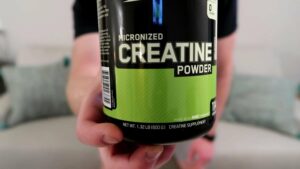Creatine is an amino acid located mostly in your body’s muscles as well as in the brain. Most people get creatine through seafood and red meat — though at levels far below those found in synthetically made creatine supplements. The body’s liver, pancreas, and kidneys also can make about 1 gram of creatine per day.
Your body stores creatine as phosphocreatine primarily in your muscles, where it’s used for energy. As a result, people take creatine orally to improve athletic performance and increase muscle mass.
People also use oral creatine to treat certain brain disorders, neuromuscular conditions, congestive heart failure, and other conditions. Topical creatine might be used to treat aging skin.
Evidence
Research on creatine use for specific activities and conditions shows:
- Strength, muscle size, and performance. Oral creatine use might allow an athlete to do more work during reps or sprints, leading to greater gains in strength, muscle mass, and performance. Creatine is often used by athletes involved in high-intensity intermittent activities that require a rapid recovery during training and competition.
- Injury prevention. Oral creatine might reduce the frequency of dehydration, muscle cramping, and injuries to the muscles, bones, ligaments, tendons, and nerves.
- Rare creatine-metabolizing syndromes. In children with certain creatine deficiency syndromes, oral creatine supplements might improve some symptoms.
- Cognition and brain health. Creatine supplementation might improve performance during cognitive tasks, especially in older adults.
- Sarcopenia and bone health. Creatine supplementation might help counteract age-related declines in skeletal muscle and bone mineral density.
- Heart failure. There isn’t enough evidence to recommend the use of oral creatine as a heart failure treatment.
- Skin aging. Early research suggests that a cream containing creatine and other ingredients applied to the face every day for six weeks might reduce skin sag and wrinkles in men. Another study suggests that a cream containing creatine and folic acid improves sun damage and reduces wrinkles.
People who have low levels of creatine — such as vegetarians — appear to benefit most from creatine supplements.
 Our take
Our take
Generally safe
Creatine might benefit athletes who need short bursts of speed or increased muscle strength, such as sprinters, weight lifters, and team sport athletes.
While taking creatine might not help all athletes, evidence suggests that it generally won’t hurt if taken as directed.
Although an older case study suggested that creatine might worsen kidney dysfunction in people with kidney disorders, creatine doesn’t appear to affect kidney function in healthy people.
Safety and side effects
When used orally at appropriate doses, creatine is likely safe to take for up to five years. As with any dietary supplement, it’s important to choose a product that follows recommended manufacturing practices and subscribes to third-party testing to ensure the product’s quality.
Creatine can cause:
- Weight gain, generally as lean body mass
Creatine might be unsafe for people with preexisting kidney problems. However, further research is needed.
Interactions
Possible interactions include:
- Caffeine. Combining caffeine with creatine might decrease the efficacy of creatine. Use of creatine with a daily amount of caffeine greater than 300 milligrams might also worsen the progression of Parkinson’s disease. Further research is needed.
- Save up to 70% on Vitamins & Supplements at eVitamins.com!
- A1Supplements.com – Lose Fat, Gain Muscle!
Creatine is one of the most common supplements that athletes take. Do you know how to use creatine to build muscle faster? Keep reading and you will find out how according to a respectable fitness trainer and kinesiologist.
Creatine is one of the most researched and used supplements in the bodybuilding community to build muscle. Therefore it is regarded as safe if taken within normal parameters.
Check Out Our List Of The Best Supplements For Building Muscle, Shredding Muscle, Recovery, Great Health, and Wellness products!
Creatine is the number-one supplement for improving performance in the gym.
Jeremy Ethier is a kinesiologist and fitness trainer, co-founder of Built With Science. His YouTube channel has over 4 million subscribers and he delivers clear information with sound background research.
Ethier uploaded a video detailing how to use creatine to build muscle faster with only 4 easy steps to follow. Check it out.
How to Use Creatine to Build Muscle Faster
How to Use Creatine to Build Muscle Faster
4 steps to build muscle faster.
1. Right Type of Creatine
There are many sorts of creatine with some kind of booster or something that enhances how your body absorbs it. A 2021 systematic review analyzed 8 different forms of creatine to determine which one is most effective.
In the end, they all came back with similar results and creatine monohydrate being the most affordable in the market.

2. How Much to Take?
Something between 1-2 grams of creatine per day is too low of a dose for you to build muscle.
The standard scoop size for most creatine products is 5 grams. However, according to research, a daily dose of 3 grams of creatine is sufficient for most lifters to increase their muscle growth. If you are a heavier-than-average person (above 200 lbs for example) you could benefit from a higher dose of creatine, but do not consume more than 5 grams per day.
3. Saturation
It often takes a few weeks for your body to saturate with creatine and begin showing results of consuming the supplement. You can saturate your body with creatine faster by applying two different tactics.
First is the loading protocol, also known as creatine loading. In short, you can consume 5 grams of creatine 4 times a day for a week to elevate your creatine store in your body – after that, you can drop to 3-5 grams of creatine per day to maintain that level of saturation.
The second method on how to use creatine to build muscle faster involves taking 3 grams of creatine from the start it will take 3-4 weeks before you start noticing the benefits of the supplement. This is known as the non-loading protocol.
4. Optimise Consumption
There is not much research that digs deep into when you should take your creatine to build muscle faster, the supplement does not have an immediate effect. So using it as a pre-workout is plain useless. In fact, taking it after a workout can be beneficial to getting stronger.
Also, research shows that taking creatine with carbohydrates and protein increases saturation levels more than just taking the supplement on its own – this is less relevant during the maintaining phase and only useful during the loading protocol.
Another study showed that taking creatine with caffeine (around 3-4 cups a day) hinders muscle growth. If not drinking coffee is impossible for you, avoid taking creatine and coffee at the same time.
Overall, make sure you are taking creatine daily and at around the same time, without caffeine, and you will build muscle faster.
Read More: Supplements Guide – All You Need to Know About Supplements

- A1Supplements.com – America’s Favorite Supplement Store.
- Free Shipping on US orders over $49 USD and 5 lbs or less at eVitamins.com!
- $5.95 Ground Shipping On Any Purchase In The US! – Shop Now!
- LivPur – advocates for safe, clean and, most importantly, low–cost yet effective nutrition!







